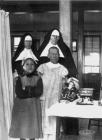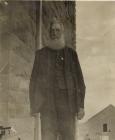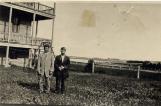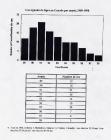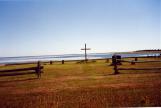

Musée Historique de Tracadie Inc.
Tracadie-Sheila, New Brunswick
2
Statistics: lepersTreated in New Brunswick (1815-1965): 327
Treated by the Religious Hospitallers (1868-1964): 180
Buried in Sheldrake Island (July 19, 1844-July 25, 1848): 15
Buried in the founders' cemetery: 94
Buried in the cemetery near the church of Tracadie (1880-1898): 42
Buried in the lepers' cemetery: 59
Buried in the 4 cemeteries: 210
Lepers: cured, released and returned in their country or buried elsewhere: 117
4
Julie Savoie 1860-1927A victim of leprosy in search of freedom
Julie Savoie, daughter of Justinien and Julie Arseneau, was born May 15th, 1860. She noticed the first signs of leprosy on her young body in 1877. Knowing full well that her fate was to be a slow and painful death coupled with a forced quarantine at the lazaretto, Julie managed to hide all signs of the disease for many years until she decided to exhile herself. She was only found 12 years later in Levis, Québec.
Her disease was then in its terminal phase. She was admitted into the lazaretto March 26th, 1906. She was locked in her room because "we feared that she would attempt to escape (...) also because she had an unpredictable disposition".
Upon her arrival in Tracadie, Julie was administered chaulmoogra oil treatments. This was the only remedy used at that time to fight against leprosy's symptoms. Doctor Langis noticed the irreversible effects of the disease and made mention of her amputations during her fist examination.
Her parents had died, she had no home, thus she remained at the lazaretto until she died of a heart attack on July 19th, 1927.
5
Sheldrake Island Bernard, called Barnabé, young boy buried in the Island1844
Sheldrake Island, New Brunswick, Canada
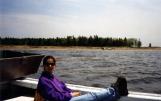
6
Bernard, called Barnabé Savoie, 1836-circa 1848Bernard Savoie, better known as Barnabé, was born in Neguac, December 22nd, 1836, son of Victor Savoie and Françoise Landry. When he was 8 years old, Barnabé disembarked on Sheldrake Island from a rowboat along with his mother Françoise, his two brothers and 17 sick others, July 19th, 1844.
The family of Victor Savoie was considered, for that time, to be well-off. Victor , Barnabé's father, was a farmer and owned wooded lots. Their house was of a good size and always well-kept. But, much like their compatriots, leprosy was ravaging their family. Françoise was the sister of the first victim of leprosy: Ursule (Landry) Benoit, daughter of Anselme Landry and Marie Brideau. Her grandfather was Alexis Landry , one of Caraquet's pioneers.
The sick at Sheldrake Island's lazaretto lived in such unhealthy conditions, that those who could excape, did. Stanislas, Marin and their young brother Barnabé were amongst the fugitives. Françoise had died. The three Savoie brothers made their way to Neguac. The laws at that time forbidded anyone to hide lepers with penalties going from heavy fines to imprisonment. Victor, their father, suggested to Stanislas and Marin that they hide in the woods near their house. Victor kept Barnabé at home because he was a little too young. Dr. Robert Bayard of Saint John(N. B.),government investigator, wrote in 1849: "Victor Savoie the Bureau of Health and his constable had come to his house and had removed by force his son Barnabé. They had tied him up and when Victor tried to save him, the lazaretto's officers pointed a pistol to his chest thus forcing him to submit".
Investigator Bayard and Wilson found Barnabé in a very poor state during their visit to Sheldrake Island in 1847. He was breathing with difficulty. His face and body were covered in sores. He probably died shortly after as he was not among the 15 survivors that were transferred to the new lazaretto in Tracadie in 1849.
7
To the memory of Jean Baptiste, son of Marguerite Robichaud1845
Sheldrake Island, New Brunswick, Canada
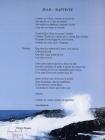
8
Marguerite Robichaud, 1813-1897Marguerite Robichaud, third child of François( to Jean) Robichaud and of Marie(to Firmin) Savoie of Tracadie, was baptized in Bartibog, November 5th, 1813. She married Jean Baptiste Saulnier, son of Pierre(to Joseph) Saulnier and of Marguerite Savoie July 16th, 1832. Her first child, Israël was born May 17th, 1833. Marguerite felt the first symptoms of leprosy after the birth of her second child, Luc, born October 24th, 1838. Suspicious spots appeared on her cheeks, nose and forehead. She lost all feeling in her fingers. Their extremities ended up falling off.
Shortly after a subsequent birth on July 19th, 1844, Marguerite, accompanied by her newborn, Jean Baptiste, entered the lazaretto on Sheldrake Island. 18 other patients had been transported there, three of which were her brothers. She stayed there for 5 years.
She was released after a treatment by Charles Labillois, new doctor at Tracadie's lazaretto. Her daughter, Lucille, born July 23nd, 1854, was only 9 when symptoms of leprosy appeared on her body. Marguerite kept her daughter home until the arrival of the nuns at the lazaretto in 1868. Marguerite's husband, Jean Baptiste, died March 13th, 1876.
Marguerite was taken in by her son, Luc, who had married Elizabeth Benoit. She stayed there until 1880 which is when she was re-admitted in to the lazaretto. She was 67. It's likely that she returned there because she had nowhere to stay as there are reports stated that the disease had re-infected her. She died May 22nd, 1897 at 83 years of age.
10
Rev. John E. DavisJohn E. Davis was born in Wicklaw, Ontaio in 1858. He became a pastor in the Baptist Church after his studies. He married Laura Lockhart and they decided to become missionaries for India in 1887. John E. Davis contracted leprosy during their 17 years of service. He would live isolated with his family for 6 years on their farm so he could watch his children grow. He asked to come to the lazaretto in Tracadie after his wife died in 1910, so he wouldn't be a burden to his children. He became a patient November 26th, 1910 and was accompanied by his brother.
In his letters to his family, he spoke of life at the lazaretto, of his doctor, Dr. Langis, of pastor Richardson, and of his good friends, as well as the care given by the nuns. Sister Pitre took charge of his correspondance during his last years as he'd gone blind. Dr. Davis died April 29th, 1926. As it was his dying wish, he was buried in his native village in Ontario.
12
Sisters Marie Pitre and Marguerite Maillet caring for the sick with two young girls affected by leprosy14
Sister E. Allard and two lepers, circa 1920Sister E. Allard and two young girls with their dolls. The girls were infected with leprosy.
Sister Allard had worked at various tasks at the lazaretto and at the hospital.
16
Madame Emma at the lazaretto from 1926 to 1964Madame Emma, a Russian woman living in Western Canada, was admitted to the lazaretto in 1926 at 30 years of age, leaving behind her husband and 4 children.
Sister Victoria Branch says:"She was treated and cured when the diasone treatment became available". Emma's extremities were affected.She also had difficulty walking. She loved to laugh and hear singing.
Marie Jane Losier, author of "Children of Lazarus" recounts a fact remembered by Mr. Fitzgerald: "I remember Mrs. Emma when she was living with the other lepers in the Ryan household. Every day I'd pass by on my way to work, she'd come to the gate to wave to me.One day she said: "A really fancy your hat". It was made of pink felt. One day I took it off my head and put it on hers. I said:"Now it's yours". She loved that hat and wore it until it was worn-out".
Madame Emma did not want to leave as she'd become an invalid and had lost touch with her family. She stayed at the lazaretto and died of a stroke or VCA in June, 1964. She was the last person to die at the lazaretto.
18
Jean Louis, a person affected by leprosyIn 1907, Jean Louis was admitted to the lazaretto at the age of 76. He died in 1915, at the age of 84. He was a native of the Northern Region of Tracadie, New Brunswick.
20
Madam Wasyl at the lazaretto from 1914 to 1924Madam Wasyl, a tall Russian, clothed in her native garb, her head covered in a red handkerchief, arrived at the lazaretto in March, 1914.
She arrived from the West Coast speaking only Russian. She left behind her husband and two young children. Her husband came to visit her two years after her departure.
It is told that she cried and missed her 12 year-old granddaughter. To console her, a nun told her: "I could be your granddaughter; I would take care of you as it would my mother". The nun learned a few Russian words. When she managed to pronounce them, Madam Wasyl would dry her tears and laugh.
She died March 13th, 1924. Doctor Langis wrote he family many times, but received no answer. Her 20 year-old son came to visit her a year later and was surprised to learn of her death. He could only see the tomb of this mother who had cried so much to once again see her children.
22
A person affected by leprosyRobert was admitted to the lazaretto at the age of 18, in 1899. His hands were affected already by the disease and he became blind a few years before he died at 38 years of age in 1919.
He was a native of the Northern Region of Tracadie, New Brunswick.
24
In 1916, Charles and Samuel at the lazaretto of Tracadie26
A leper at the lazaretto, 1937-1964Mr. Hum, Chineese and Neocanadian arrived in November, 1937. He lived many years at the lazaretto and was cured of leprosy. However, he'd lost contact with his family at that time and did not want to leave. He said that his home was with the personnel and the nuns. He died of uraemia whilst still residing at the lazaretto in February, 1964.
We hear that Mr. Hum ordered various imported foods from Montreal, as well as vegetable seeds that he planted in his little garden. He also did carpentry as he had his own tools and a small shed near the bay.
Sister V. Branche spoke of his kindness, that he never fought with anyone, and of the love that he had for everyone.
At the request of the nuns at the lazaretto, they prepared him for his baptism in 1946. Missionary nuns that spoke Chineese come to visit the Chineese patients, which included Hum.
28
Number of cases of leprosy registred in Canada by year, 1989-1998In 1998: 3 cases: Alberta 1; Manitoba 1; Ontario 1; 2 males, 1 female; 1 case between age 15-19; 1 case between age 20-24; 1 case between age 40-59.
Ref. Canada Health(2000)
Year Number of cases
89 12
90 18
91 21
92 16
93 13
94 10
95 10
96 07
97 04
98 03
30
Founders' cemetery, 1798-1880Here lie Tracadie's first inhabitants. 94 persons were identified as suffering from leprosy among these tombs.



